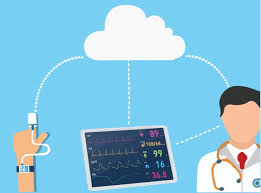 Remote patient monitoring (RPM) is enables monitoring of patients outside of conventional clinical settings, which may increase access to care and decrease healthcare delivery costs.
Remote patient monitoring (RPM) is enables monitoring of patients outside of conventional clinical settings, which may increase access to care and decrease healthcare delivery costs.
RPM involves the constant remote care of patients, often to track physical symptoms, chronic conditions, or post-hospitalization rehab.
Remote patient monitoring’s goal is to collect and transmit health data to improve outcomes by capturing lifestyle behaviors that could be changed such as sleep, activity, controlling risk factors, and detecting, clinical deterioration, or a change in health status before it worsens.
Remote monitoring of cardiac implantable electronic devices, such as pacemakers, defibrillators and insertable cardiac monitors can detect arrhythmias, alert for the need of changes in therapies, and allow changes in pacing, provide early warning systems for lead failure of battery depletion.
Some implantable defibrillators can identify heart failure status using impedance, activity and respiratory rate studies.
Volume status can be monitored with implantable sensors that measure pulmonary artery pressure.
Such measurements can act as a surrogate for left ventricular filling pressures, enabling the detection of early heart failure.
Digital health technologies (DHT) including mobile health apps, telehealth platforms are used to integrate cardiovascular medicine to support patient care, clinical interactions, and interpretation of imaging.
DHT’s capture patients physiological data, which is transmitted to and used by cardiovascular care teams to manage risk factors and disease.
Wearable DHT’s can capture continuous or semi continuous information/measurements that can be captured without patient initiation, such as pulse rate, oxygen saturation, respiratory rate, heart rate, and cardiac rhythm.
Common wearable DHTs include smart watches, and other wrist worn devices can, skin surface patches, wearable EKG devices that use leads an electrodes.
Incorporating RPM in chronic-disease management by delivering care through telecommunications may significantly improve an individual’s quality of life, by allowing patients to maintain independence, prevent complications, and to minimize personal costs.
DHT enable early detection of deterioration; thereby reducing emergency department visits, hospitalizations, and the duration of hospital stays.
During the COVID-19 pandemic, Remote Patient Monitoring has been used extensively and allowed for more fields such as psychology or cardiology to use virtual care.
RPM provides better patient compliance and improved physician management, while decreasing costs of care.
Access to the RPM record anytime from anywhere, can access help in making accurate health decisions and improves clinical operations.
RPM helps in faster decision making, as it collects, improves, and analyzes data promptly.
Most RPM technologies consists of four components:
Sensors on a device that is enabled by wireless communications to measure physiological parameters.
Sensors can connect back to a central database by WiFi or cellular communication protocols .
Local data storage at patients’ site that interfaces between sensors and other centralized data repository and/or healthcare providers.
Centralized repository to store data sent from sensors, for local data storage, for diagnostic applications, and to healthcare providers.
Treatment recommendations and intervention are based on the analysis of collected data.
Physiological data such as blood pressure and subjective patient data are collected by sensors on peripheral devices, and include blood pressure, pulse oximeter, and glucometer.
Remote monitoring technologies help to lower severity of pain as well as improving depression.
The RPM has improved the life expectancy of Cancer Patients up to 20%, helping in early interventions, prescriptions, chemotherapy modifications, reducing emergency room visits or prolonged chemotherapy treatments.
Studies estimate that the hospitalization rate of patients with RPM is 2.8% and without RPM is 13%.
RPM is a necessary means of providing care to at-risk patients such as elderly or immunocompromised people.
For patients with dementia that are at risk for falls, RPM technology promotes safety and prevents harm through continuous surveillance.
Such remote sensors can be affixed to the individual or their assistive mobility devices such as canes and walkers.
The sensors can monitor a patients location, gait, linear acceleration and angular velocity, and can predict the likelihood for falls, detect movement changes, and alert if the individual fall.
The real-time delivery of blood glucose and blood pressure readings enables ihealthcare providers to intervene when needed.
Daily diabetes management involving RPM is just as effective as usual clinic visit every 3 months.
Heart failure patients indicates that RPM improves quality of life, improves patient-provider relationships, shortens duration of stay in hospitals, decreases mortality rate, and reduces costs to the healthcare system.
Post-surgical remote patient monitoring detected 30% more medication errors, 10-14% reduction in patient paint, and a 5% reduction in hospital re-admissions.
There is mixed evidence on the impact and outcomes of telehealth usage in prisons.
VH findings indicate improvements in a wide range of metrics, including decrease in emergency department visits, hospitalizations, and nursing home admissions, resulted in significant savings to the organization.
Whole System Demonstrator Trial in UK:
45% reduction in mortality rates
20% reduction in emergency admissions
15% reduction in A&E visits
14% reduction in elective admissions
14% reduction in bed days
RPM is very dependent on the individual’s motivation to manage their health.
Since RPM involves transmission of sensitive patient data across telecommunication networks, information security is a concern.
Medicare fully covers doctors and other medical staff receiving payment for RPM patient setup and training. This
Medicaid also covers these procedures in 34 states.
A randomized controlled trial involving congestive heart failure patients concluded that the use of telemonitoring failed to provide a benefit over usual care.
